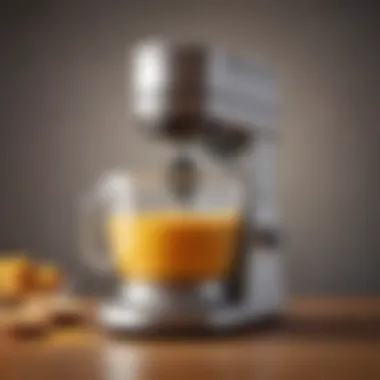Exploring the Baking Blender Machine: A Comprehensive Insight


Intro
The evolution of the kitchen appliance landscape has carved a unique niche for baking blender machines. These devices embody a fusion of traditional baking methods and modern technology. Their emergence revolutionizes how both novice home bakers and experienced professionals approach various baking tasks.
From kneading doughs to mixing batter, baking blender machines offer functionalities that streamline processes. The versatility they bring allows users to explore a wider range of recipes with greater ease. This article aims to not only highlight the innovative features of these machines but also guide readers through their selection and optimal usage.
Understanding what makes a baking blender machine significant is essential. The emphasis on technological advancements, coupled with a comprehensive analysis of available models, positions this overview as a valuable resource for anyone keen on enhancing their baking skills.
Preface to Baking Blender Machines
The increasing popularity of home baking has led to significant interest in baking blender machines. These apparatuses combine the functionality of traditional blenders with features tailored for baking, making them essential for both amateur and professional kitchens. Understanding the implications of utilizing a baking blender machine can enhance the baking experience and optimize results.
The relevance of baking blenders lies not only in their innovative design but also in their capacity to simplify the baking process. They offer a way for bakers to achieve consistent textures in batters and doughs, which can be crucial for successful results. This section aims to provide insights into the historical developments and evolutions in kitchen appliances that have influenced the design and functionality of baking blender machines.
Historical Context
The history of baking blender machines is a reflection of wider trends in kitchen technology. For instance, the early 20th century saw the introduction of basic electric mixers. These devices made it easier to mix ingredients but had limitations in terms of versatility. As culinary needs evolved, so did kitchen appliances. The advent of multiple kitchen gadgets led to the recognition that combining functionalities would enhance user convenience.
The innovation cycle in kitchen technology accelerated in the latter half of the century. Key brands introduced more sophisticated designs aimed at merging the capabilities of blenders and mixers. This period set the stage for machines that could handle a variety of baking tasks, from blending to kneading. This historical perspective provides a foundation for understanding how baking blender machines arose from the need for efficiency and multifunctionality in our kitchens.
The Evolution of Kitchen Appliances
The evolution of kitchen appliances has been marked by a steady drive towards innovation. In earlier years, bakers relied on manual techniques for mixing and kneading, which were time-consuming and labor-intensive. The introduction of electric mixers was a turning point. It allowed bakers to achieve more consistent results while freeing up time for other creative culinary activities.
Today, baking blender machines represent the culmination of decades of advancements. They integrate technology that was once separate, allowing for hybrid usage. Features such as programmable settings, variable speeds, and specialized attachments enhance their functionality. For instance, some models are designed specifically for creating dough, while others excel in blending ingredients for smooth batters. This versatility creates a more efficient workflow in the kitchen.
Understanding the progression from basic mixers to advanced baking blender machines provides valuable context for users. It allows them to appreciate the features available and how they can utilize these machines to their advantage, ultimately enhancing the art of baking.
Understanding the Functionality
Understanding the functionality of baking blender machines is essential for any enthusiast looking to enhance their culinary skills. These machines simplify the complex process of baking by combining the functions of a traditional blender with those of baking tools. They not only blend ingredients but also prepare mixtures that require precise consistency, making them versatile in any kitchen.
The technology encapsulated within baking blender machines addresses several key aspects: efficiency, versatility, and user-friendliness. Holding advanced features, these machines can process doughs, batters, and even incorporate delicate ingredients like eggs without compromising textural integrity.
The modern baking blender machine evolves with user needs, adapting to the different baking styles and preferences. It is crucial to assess how these machines contribute to the overall baking experience.
Key Components and Features
Baking blender machines consist of various components that enhance their overall functionality. Understanding these elements can aid potential buyers in making informed decisions.
- Motor Power: A powerful motor ensures that the machine can handle tough blending tasks, especially when mixing dense doughs or heavy batters.
- Blending Blade: The design and quality of the blades directly impact the efficiency and consistency of the mixtures produced. Sharp, durable blades can reduce preparation time and enhance the final product's quality.
- Variable Speed Settings: This feature allows users to adjust the speed according to their needs, accommodating both delicate mixing and robust blending tasks.
- Integration Options: Some machines offer attachments for specifically designed tasks, such as kneading dough, making them multipurpose appliances.
- Ease of Cleaning: Machines that disassemble easily allow users to clean components thoroughly, maintaining hygiene and functionality.
Baking vs. Blending: A Distinction
While baking and blending are often interconnected, there are distinct differences that users should understand.
- Baking typically involves combining ingredients and subjecting them to heat, transforming raw materials into edible products. Ingredients undergo changes in structure and flavor through the baking process.
- Blending, on the other hand, focuses on preparing mixtures without necessarily applying heat. This process is crucial for achieving desired textures such as smooth batters or whipped creams.
In context, a baking blender machine harmonizes both functions, allowing users to easily switch from mixing to blending. Recognizing this distinction enables bakers to utilize their machines more effectively, maximizing efficiency and output.
By grasping the core functionality of baking blender machines, users can better navigate their features and apply them in their baking practices.


"Understanding the intricate functionalities of your baking blender machine significantly enhances both efficiency and final results in your culinary endeavors."
This knowledge not only boosts confidence in the kitchen but also elevates the baking experience to a new level.
Market Analysis of Baking Blender Machines
In today's culinary landscape, the market analysis of baking blender machines holds significant importance. This section delves into various aspects that contribute to understanding the demand, features, and leading players in the industry. With the rise of home baking and culinary experimentation, knowing the options available assists consumers in making well-informed decisions. Key elements to consider include brand reputation, pricing strategies, and technological advancements that enhance the user experience.
Top Brands and Models
Several brands stand out in the baking blender machine market, each offering unique features and innovations. Brands like KitchenAid, Breville, and Cuisinart have established themselves as leaders. Each model serves different baking needs, from casual home bakers to professional chefs.
- KitchenAid Artisan Blender – Known for its versatility and robust build, it is a favorite among enthusiasts.
- Breville BBL910XL – This model combines blending and baking functionalities seamlessly.
- Cuisinart CBK-200 – A reliable choice, especially for those focusing on automated baking processes.
These brands frequently update their offerings, reflecting changing consumer preferences and technological advances. It is essential for potential buyers to assess their needs and conduct thorough research on these and other models in the market.
Performance Comparison
When comparing the performance of baking blender machines, various factors come into play. These include blending efficiency, ease of use, and cleanup. Many users prioritize machines that quickly handle tasks without sacrificing quality. Performance can also involve noise levels, which vary by model.
Factors to Consider:
- Blending Speed: How fast a machine can shift from blending to baking mode.
- Power Capability: Models with higher wattage generally perform better.
- User Ease: Intuitive controls and easily accessible functions can enhance the overall experience.
In comparing models, customer reviews and expert ratings can significantly influence perception. High-quality performance typically translates to increased satisfaction rates among users.
Ultimately, the understanding of different models and their functionalities aids potential customers in choosing a baking blender machine that aligns with their baking ambitions and requirements.
"Understanding the specific features and performance metrics can significantly impact one's baking experience with blender machines."
Advantages of Using a Baking Blender Machine
Baking blender machines represent a significant advancement in culinary technology. These devices streamline various baking processes, making them an essential tool for both home bakers and professionals. Understanding the advantages of using these machines can help users maximize their baking experience, improving the quality of their baked goods while saving precious time. In this section, we will explore two key advantages: time efficiency and consistency in baking.
Time Efficiency
One of the primary benefits of baking blender machines is their ability to save time. In the world of baking, speed can have a substantial effect on productivity. A baking blender machine combines the functions of blending and baking, reducing the need for multiple appliances. This multi-functionality allows for a significant reduction in the preparation and cleaning time.
Instead of manually mixing ingredients or waiting for separate appliances to finish their tasks, the baking blender can achieve desired consistencies and mix thoroughly in a shorter period. Users can simply add all ingredients to the machine, set the desired program, and walk away.
- Quick Mixing: Baking blender machines are designed to expertly combine ingredients quickly. This is particularly useful for recipes requiring lengthy mixing times.
- Automated Processes: Many models feature automated programs that take care of specific baking tasks, allowing users to focus on other kitchen duties.
- Reduced Cleanup: With fewer tools used in the process, cleaning becomes less daunting. A baking machine typically has fewer components, minimizing the hassle after cooking.
Consistency in Baking
Consistency is a vital aspect of successful baking. Achieving uniformity in texture and flavor is often what separates professional suites from the average kitchen. Baking blender machines excel in delivering consistent results with every batch.
The precise control over blending speeds and times ensures that ingredients are mixed to the perfect standard. Unlike manual mixing, which can be influenced by the user’s technique, these machines offer reliability.
- Controlled Mixing: A baking blender machine can maintain a consistent speed and duration, which helps prevent over-mixing or under-mixing ingredients. This is crucial in recipes like bread, where gluten development is vital.
- Temperature Regulation: Some advanced models incorporate temperature control, ensuring that ingredients remain within an optimal range, which is particularly useful for sensitive recipes.
- Repeatability: By using preset programs, users can replicate successful recipes without guesswork, making it easier to maintain quality across multiple batches.
With the use of baking blender machines, users experience reduced time in meal prep and a higher standard in consistency which collectively enhance the baking experience.
In summary, the advantages of using a baking blender machine in culinary practices are clear. Time efficiency and consistent quality contribute to a more enjoyable and effective baking process. As we continue to explore practical applications of this tool, it becomes evident how significant these benefits are for anyone involved in baking.


Practical Applications in Baking
The baking blender machine is not just a tool; it is essential in executing various baking applications efficiently. The versatility offered by these machines allows users to explore creative avenues in their baking endeavors. Using a baking blender can save time and enhance the quality of baked goods. This section delves into the specific applications, showcasing the importance of this technology in bread making, cake preparation, and pastry creation.
Bread Making
Bread making is a fundamental baking application where the baking blender shines. These machines streamline the preparation by combining ingredients uniformly. This consistency ensures that the dough achieves the right texture, which is crucial for fermentation.
The baking blender can accommodate various types of flour and additional ingredients, providing flexibility. For instance, users can mix whole grain flours, seeds, and nuts without compromising on texture. Factors such as dough kneading time and speed settings can be adjusted. By using a baking blender, achieving the perfect dough for classic sourdough or a light brioche is more achievable.
Cake Preparation
The process of preparing cakes can be complex, requiring precision in both mixing and timing. Baking blenders simplify this process. They allow for the even incorporation of ingredients, which leads to a uniform batter. This uniformity is vital for the rise and texture of cakes. From airy sponge cakes to dense brownies, a baking blender can flexibly adjust to the needs of varying cake recipes.
One significant advantage is the speed of preparation. The machines can rapidly mix wet and dry ingredients, ensuring that air is properly incorporated. This efficiency not only saves time but also contributes to the quality of the final product.
Pastry Creation
Pastry creation often requires delicate handling of ingredients, especially when it comes to butter and flour. A baking blender can assist in mixing these ingredients without overworking the dough. This gentle approach is critical in pastry-making, where texture should be flaky and light.
Additionally, the precision of measurement in a baking blender can significantly improve outcomes. Exact quantities can be blended to create the ideal pastry. It supports various recipes, from shortcrust to puff pastry, giving bakers a reliable tool for diverse creations.
"A reliable baking blender offers unmatched efficiency, facilitating the journey from simple ingredients to exquisite baked goods."
In summary, the baking blender is a transformative tool that enhances baking disciplines such as bread making, cake preparation, and pastry creation. Its multifunctional capabilities bring qualitative improvements, making it a valuable addition to both amateur and professional kitchens.
Tips for Maximizing Baking Blender Efficiency
To gain the full potential of a baking blender machine, one must understand not only how to use it but also how to utilize it effectively. A clear grasp of best practices in operation can yield better results and enhance the experience of baking enthusiasts. Below, we explore vital elements to consider for optimal baking blender efficiency.
Best Practices for Use
- Read the Manual: Each baking blender model comes with its unique features. Taking time to read the user manual provides valuable insights into specific functionalities and recipes tailored for the device.
- Pre-measure Ingredients: Before starting the mixing process, measure all ingredients accurately. This practice minimizes effort and ensures the correct texture and taste.
- Layering Ingredients: When adding ingredients into the blender, place the liquids first, followed by dry ingredients. This increases blending efficiency and avoids dry clumps.
- Adjust Speeds Gradually: Begin blending at a lower speed and gradually increase as necessary. This prevents splattering and ensures a smoother mixture.
- Utilize Pulse Function: The pulse feature can be useful for coarse blends or when incorporating delicate ingredients. This gives more control and requires less precise timing.
- Avoid Overfilling: Adhere to the blender’s limits to achieve the best mixing results. Overfilling can lead to spilling or uneven texture.
Using these practices will enable users to create delightful baked goods with less frustration and more satisfaction.
Maintenance and Care
Proper maintenance and care for a baking blender machine are crucial for longevity and consistent performance. Meticulous attention to cleaning and upkeep can prevent common issues that might arise from neglect.
- Regular Cleaning After Each Use: Clean the blending jar immediately after use. Dish soap and warm water can effectively remove residue. For tougher mixtures, a blend of warm water and soap can be mixed in the jar and run briefly to assist in cleaning.
- Check for Wear and Tear: Regularly inspect blades and gaskets for signs of damage. Replacement parts should be ordered timely to maintain performance.
- Avoid Abrasive Materials: Use soft sponges or cloth for cleaning. Harsh scrubbers can scratch surfaces and compromise the integrity of the machine.
- Store Properly: After ensuring that all components are completely dry, store the machine in a cool, dry place. Avoid stacking other items on top that might cause damage.
- Occasional Deep Cleaning: Every few months, consider a deep clean for internal components. Following the manufacturer's instructions for this process is crucial to maintain performance.
By adhering to these maintenance tips, users can ensure that their baking blender machine functions optimally over the long term. This not only preserves its efficiency but also enhances the overall baking experience.
"Taking care of your baking blender machine is not just about prolonging its life. It's about ensuring that it continues to be your reliable ally in the kitchen."
With these guidelines, baking enthusiasts can optimize their use of baking blender machines while ensuring durability and effectiveness.
Common Challenges and Troubleshooting
Understanding the common challenges associated with baking blender machines is crucial for those looking to optimize their use. These challenges can undermine the efficiency and effectiveness of the machine, leading to unsatisfactory results. By addressing potential issues, bakers can enhance their experience and fully utilize the capabilities of these versatile appliances. Whether you are a novice or an experienced baker, being aware of what can go wrong will prepare you for a smoother baking process.


Common Issues Faced
One common problem that users encounter involves the blender's motor overheating. High temperatures can arise from continuous use or when blending dense mixtures like bread dough. This can lead to a machine that either shuts off or works less efficiently. Another frequent issue is poor mixing, which might be due to improper loading of ingredients. If not layered correctly, certain materials may not mix well, resulting in uneven batter or dough consistency.
Other notable challenges include the blades getting stuck or becoming dull over time. This often happens with thicker mixtures or when users attempt to blend ingredients that the machine is not designed to handle. Additionally, residue can build up in the bowl and around the blades, leading to hygiene issues and decreased performance.
Effective Solutions
To combat overheating, it is essential to allow the machine some cooling time after extended use. Following the manufacturer guidelines for optimal usage time will help prevent this issue. When loading ingredients, always layer them correctly. Liquids should go in first, followed by soft ingredients, and then dry materials on top. This ensures a better blend and prevents jams.
For blade-related problems, regularly check for wear and tear. Replacing blades as needed can maintain optimal performance. Cleaning the container properly after each use is vital to avoid buildup. You might want to use a brush specifically designed for this purpose to reach every corner of the bowl.
Regular maintenance and smart usage can dramatically enhance the life and efficiency of your baking blender machine.
Below are practical tips that can further alleviate some common challenges:
- Monitor overheating: Keep an eye on the temperature during usage.
- Layer ingredients correctly: Follow proper order for optimal blending.
- Inspect and replace blades: Maintain sharpness for better results.
- Thorough Cleaning: Ensure the machine is cleaned after using to prevent buildup.
By understanding the common issues and employing effective solutions, users can mitigate challenges, ensuring a more satisfactory baking experience.
The Future of Baking Blender Technology
The baked goods industry is evolving rapidly, driven by advancements in technology. Understanding the future of baking blender technology is crucial for any culinary enthusiast or professional baker. It signifies not just the evolution of kitchen appliances but also the potential enhancements in the baking process. This section explores what lies ahead in this fascinating segment of kitchen machinery, considering key innovations and evolving market trends that will influence both production and consumption.
Innovations on the Horizon
Innovation in baking blender technology is geared towards enhancing efficiency, adaptability, and user-friendliness. A few noteworthy advancements include:
- Smart Technology Integration: Many manufacturers are incorporating smart features that can be controlled via mobile applications. Users can access recipes, customize settings, and monitor their baking in real-time.
- Advanced Blending Mechanisms: New blending technologies, such as dual-action blades and variable speed options, improve uniformity in mixing ingredients. This ensures a more consistent texture in the final product.
- Sustainable Materials: As environmental concerns grow, many brands are shifting towards eco-friendly materials for casing and components. These materials not only contribute to a healthier planet but also often provide better durability.
With smart cooking technology, the future of baking is not just about mixing ingredients; it is about creating a personalized baking experience.
- Multi-Functionality: Future models are expected to become even more versatile, allowing users to bake, blend, and perform other culinary tasks with one appliance. This aligns with the growing preference for minimalist kitchen solutions.
- Enhanced Safety Features: Innovations around user safety are crucial. Expect features such as automatic shut-off, child-lock settings, and heat-resistant materials to become standard.
Potential Market Trends
The potential trends within the baking blender market reflect broader shifts in consumer behavior and lifestyle. These trends may include:
- Health-Conscious Baking: Increased awareness of health issues is driving demand for appliances that can prepare healthier baked goods. Consumers are looking for machines that can accommodate gluten-free, low-sugar, and alternative ingredient baking.
- Home Baking Resurgence: The COVID-19 pandemic initiated a surge in home baking activities. This trend is likely to continue, motivating manufacturers to create machines tailored to the home baker’s needs.
- Regional Variations: As baking techniques vary across cultures, there will be a market for specialized machines designed for specific regional baking practices. Consumers might seek appliances that can cater to traditional recipes, such as Italian Panettone or French Croissants.
- Subscription Models: There is a rising interest in subscription services that provide ingredients and recipes tailored to existing baking blender models. This can simplify the process for users and encourage them to experiment with new recipes.
- Customization and Personalization: Customers appreciate the ability to customize their baking experiences. Future products may offer personalization options, allowing users to adjust not just settings, but also appearance via interchangeable parts or colors.
Ending
The conclusion of this article reiterates the implications of using baking blender machines in contemporary kitchens. These machines represent a significant advancement in baking technology. As described throughout the article, they integrate multiple functionalities, making them valuable tools for both novice and experienced bakers.
Summary of Insights
Throughout this exploration, several key insights emerge:
- Versatility: Baking blender machines are not limited to just one function. They serve various purposes, such as mixing, blending, and even kneading dough. This adaptability is advantageous for different baking projects.
- Time-Saving: Using these machines can dramatically reduce preparation time. Mixing and blending require less manual effort, allowing bakers to focus on other tasks.
- Consistency and Quality: The precision offered by baking blenders leads to more consistent results, which is crucial for recipes requiring exact measurements and techniques.
- Technological Innovation: Recent advancements in baking blender technology have improved their performance and usability. Smart features are now common in many models, contributing to an enhanced baking experience.
Baking blender machines not only streamline the process but also elevate the quality of the final product. For those who wish to improve their baking skills, understanding and adopting this technology is essential.
Final Thoughts on Adoption
Adopting a baking blender machine presents numerous benefits. However, potential users should consider a few factors before making a purchase:
- Model Selection: Different models vary in features. It is important to evaluate what specific functionality will best suit your baking habits.
- Budget: Prices can range significantly. Establishing a budget before shopping will help direct your choices to more suitable models.
- User Reviews: Insights from other users can provide valuable information about the performance and reliability of specific machines.
In summary, the integration of baking blender machines into one's kitchen is not just about convenience; it is about enhancing the overall baking experience. For enthusiasts and professionals alike, these machines can lead to improved skills and better outcomes in baking endeavors.







